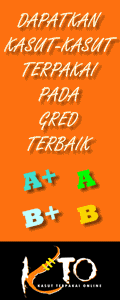Know Your Tyre Sidewall Markings
Posted by pahaikan on Monday, December 13, 2010 Under: Kereta

KAISER, China made tyre...
Tyres are designed and built to provide many thousands of miles of excellent service. I have just change both of my rear tyre with new ones. Change from Made in Indonesia to a Made in China tyre. From my experience, imported tyre last longer longer than Malaysian tyre.. I don't know why? But a country that is rated as the number 3 largest producer of natural rubber in the world make a average quality tyres? And at the same market price?... Huh...
Nevermind la... Back to the original topic....
Tyres have a code system moulded into their sidewall which allows you to understand their technical capabilities. This code provides information on the tyre's construction (e.g. radial), its size, its load-carrying capacity and its speed rating.
For example, the code on my Wira SE is: 205/45R16 87V
205 | Indicates the nominal section width of the tyre in millimeters (205mm). |
45 | Indicates its aspect ratio, a comparison of the tyre's section height with its section width (45 indicates the height is 45% of its width). |
R | Indicates radial ply construction. |
16 | Indicates the nominal diameter of the wheel rim (16 inches) |
87 | Indicates the maximum load capacity at which the tyre can be safely operated, subject to the tyre being in sound condition, correctly fitted, and with recommended inflation pressures (87 represents a maximum load of 545kg per tyre. |
V | Indicates the speed rating. V represents a maximum speed of 240km/h. |
Type Of Ply Construction Fabric On The Tyre
- R: radial
- B: bias belt
- D: diagonal

Radial, Bias and Diagonal ply construction fabric patterns
Most tyre in Malaysian market are radial ply. Maybe because it last longer, improves handling and greater mileage.
Point To Note: Radial design avoids having the plies rub against each other as the tyre
flexes, reducing the rolling friction of the tyre. This allows vehicles
with radial tyres to achieve better fuel economy than vehicles with bias-ply tyres. (http://en.wikipedia.org/wiki/Radial_tire)
Passenger Car Tyre Load Ratings (http://www.bridgestone.com.au/tyres/passenger/care/markings.aspx)
Click here for more: Standard Load Inflation Table
Passenger Car Tyre Speed Ratings (http://en.wikipedia.org/wiki/Tire_code)
Prior to 1991, tire speed ratings were shown inside the tire size, before the "R" character. The available codes were SR (112 mph, 180 km/h), HR (130 mph, 210 km/h), VR (in excess of 130 mph, 210 km/h) and ZR (in excess of 149 mph, 240 km/h). The ZR code is still in common use, often combined with a W or Y speed code.
Example: 205/45ZR16 87W
Tyre Age
Malaysia has been a place to "dump" second hand vehicle for quite some times. So, Malaysian are "well-trained" in using second hand parts and the most popular component is 2nd hand tyre.
Although I am also using second hand tyre (sometimes), I am very cautious about the age of the tyre. You can refer the tyre age by searching for three digit age code on the sidewall. This number indicates the month and year of manufacture. For example 129 means the tyre was manufactured in December 1999.
Additional markings
There are numerous other markings on a typical tire, these may include:
http://en.wikipedia.org/wiki/Tire
http://en.wikipedia.org/wiki/Tire_code
http://www.tyrepac.com.my/Form/B2C/TyreEducational.aspx
http://www.carbibles.com/tyre_bible.html
http://www.fulda.com/fulda_uk_en/test_and_tips/tyre_technology/how_to_read_a_tyre/index.jsp
REMARKS: Don't forget to check the tyre pressure too...
Passenger Car Tyre Load Ratings (http://www.bridgestone.com.au/tyres/passenger/care/markings.aspx)
| Load Index | 81 | 82 | 85 | 86 | 87 | 88 | 90 | 92 |
|---|---|---|---|---|---|---|---|---|
| Max Load/tyre (kg) | 462 | 475 | 515 | 530 | 545 | 560 | 600 | 630 |
Click here for more: Standard Load Inflation Table
Passenger Car Tyre Speed Ratings (http://en.wikipedia.org/wiki/Tire_code)
| Code | mph | km/h | Code | mph | km/h | Code | mph | km/h | |||
|---|---|---|---|---|---|---|---|---|---|---|---|
| A1 | 3 | 5 | A2 | 6 | 10 | A3 | 9 | 15 | |||
| A4 | 12 | 20 | A5 | 16 | 25 | A6 | 19 | 30 | |||
| A7 | 22 | 35 | A8 | 25 | 40 | B | 31 | 50 | |||
| C | 37 | 60 | D | 40 | 65 | E | 43 | 70 | |||
| F | 50 | 80 | G | 56 | 90 | H | 130 | 210 | |||
| J | 62 | 100 | K | 68 | 110 | L | 75 | 120 | |||
| M | 81 | 130 | N | 87 | 140 | P | 94 | 150 | |||
| Q | 100 | 160 | R | 106 | 170 | S | 112 | 180 | |||
| T | 118 | 190 | U | 124 | 200 | V | 149 | 240 | |||
| Z | > 149 | > 240 | W | 168 | 270 | (W) | > 168 | > 270 | |||
| Y | 186 | 300 | (Y) | > 186 | > 300 |
Prior to 1991, tire speed ratings were shown inside the tire size, before the "R" character. The available codes were SR (112 mph, 180 km/h), HR (130 mph, 210 km/h), VR (in excess of 130 mph, 210 km/h) and ZR (in excess of 149 mph, 240 km/h). The ZR code is still in common use, often combined with a W or Y speed code.
Example: 205/45ZR16 87W
Tyre Age
Malaysia has been a place to "dump" second hand vehicle for quite some times. So, Malaysian are "well-trained" in using second hand parts and the most popular component is 2nd hand tyre.
Although I am also using second hand tyre (sometimes), I am very cautious about the age of the tyre. You can refer the tyre age by searching for three digit age code on the sidewall. This number indicates the month and year of manufacture. For example 129 means the tyre was manufactured in December 1999.
Additional markings
There are numerous other markings on a typical tire, these may include:
- M+S, or M&S: Mud and Snow; all-weather tires, with above-average traction in muddy or very light snowy conditions, and for low ambient temperatures. A winter tire even if doesn't has the snowflake and mountain symbol. Spike tires have an additional letter, "E" (M+SE).
- BSW: Black SideWall
- WSW: White SideWall
- OWL: Outline White Lettering
- VSB: Vertical Serrated Band
- E4: Tire approved according ECE-regulations, the number indicating the country of approval.
- 030908: Approval number of the tire
- DOT code: All tires for use in the USA have the DOT code, as required by the Department of Transportation (DOT). It specifies the company, factory, mold, batch, and date of production (2 digits for week of the year plus 2 digits for year; or 2 digits for week of the year plus 1 digit for year for tires made prior to 2000). Although not law, some tire manufacturers do not suggest using a "new" tire that has been sitting on the shelf for more than 6 years (Ford Motor Company) or 10 years (Cooper Tire citing a tire association recommendation).
- TL: Tubeless
- TT: Tube-type, tire must be used with an inner-tube
- Made in ...: Country of production
- C: Commercial; tires for light trucks (Example: 185 R14 C)
- B: Bias belted; tires for motorcycles (Example: 150/70 B 17 69 H)—diagonal construction with belt added under the tread
- SFI, or Inner: Side Facing Inwards; inside of asymmetric tires
- SFO, or Outer: Side Facing Outwards; outside of asymmetric tires
- TWI: Tread Wear Indicator; a device, such as a triangle or a small Michelin Man icon, located where the tread meets the sidewall. It indicates the location of the raised wear bars in between the tire tread channels.
- LL: Light Load; tires for light usage and loads
- SL: Standard Load; tire for normal usage and loads
- XL: eXtra Load; tire for vehicles of heavier standard weights
- RF: Reinforced tires
- Arrows: Some tread designs are "directional", and designed to perform better when driven in a specific direction (clockwise or counter-clockwise). Such tires will have an arrow showing which way the tire should rotate when the vehicle is moving forwards. It is important not to put a "clockwise" tire on the left hand side of the car or a "counter-clockwise" tire on the right side.
- M0: Original tires for Mercedes-Benz
- N*: Original tires for Porsche
- "Star": Original tires for BMW
http://en.wikipedia.org/wiki/Tire
http://en.wikipedia.org/wiki/Tire_code
http://www.tyrepac.com.my/Form/B2C/TyreEducational.aspx
http://www.carbibles.com/tyre_bible.html
http://www.fulda.com/fulda_uk_en/test_and_tips/tyre_technology/how_to_read_a_tyre/index.jsp
REMARKS: Don't forget to check the tyre pressure too...
In : Kereta
Tags: "tyre tire sidewall markings code"
blog comments powered by Disqus












